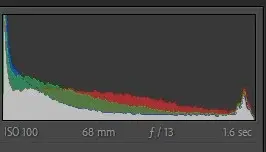- Joined
- Mar 29, 2016
- Messages
- 15,954
- Reaction score
- 9,398
- Can others edit my Photos
- Photos NOT OK to edit
- Moderator 🛠️
- #121
Again you are totally missing the point. I didn't say I had problems with noise or blown highlights. I said "I know how far I can push the ETTR for a maximum white of RGB 255.255.255, (that's not blown), the most shadow detail possible for the DR of the scene (as Joe mentioned above the highest SNR for the exposure), and a full sensor. Random noise in the shadows is always present but increases as the SNR decreases, if you apply gain post to raise the exposure that noise also gets boosted. If you eliminate it prepost processing by maintaining a higher SNR then it isn't as much a problem in post processing. ETTL (under exposing) can help retain highlight details in a scene but at the risk of increased noise in the shadows, fewer discrete tones, and a decrease in micro transition. There are no downsides to striving for a full sensor (neither over or under exposed) exposure.He listed blown highlights and noise in shadows.
Sorry, but all the rest of your post is pretty much nonsensical ramblings.










![[No title]](/data/xfmg/thumbnail/41/41898-2c70795ddfa6b397714acc28e3e5d36f.jpg?1734176252)






